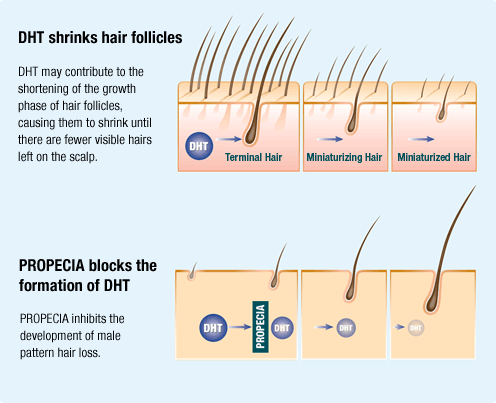 Male pattern baldness is one of the most common forms of hair loss that happens in men. It is also known as genetic hair loss or alopecia androgenic. Hair loss normally happens slowly; usually they start to notice bald spot on the crown of the scalp. Depending on the individual’s health, many start to see thinning of the hair around the temple area as they reach their thirties. Your hair goes through different phases; your hair growth cycle normally lasts for two to three years, it grows approximately 1cm every month. Your hair grows and then rests for couple of months and then falls out, after couple of days new hair starts to grow in its position. It is normal to shed some hair everyday but if a person starts to see excessive hair loss then it is a sign of male pattern baldness.
Male pattern baldness is one of the most common forms of hair loss that happens in men. It is also known as genetic hair loss or alopecia androgenic. Hair loss normally happens slowly; usually they start to notice bald spot on the crown of the scalp. Depending on the individual’s health, many start to see thinning of the hair around the temple area as they reach their thirties. Your hair goes through different phases; your hair growth cycle normally lasts for two to three years, it grows approximately 1cm every month. Your hair grows and then rests for couple of months and then falls out, after couple of days new hair starts to grow in its position. It is normal to shed some hair everyday but if a person starts to see excessive hair loss then it is a sign of male pattern baldness.
There are so many reasons why excessive hair loss takes place in both men and women. For example a person maybe ill for couple of months or it can be someone who came out from surgery, or if the person is stressed out, they may see a large amount of hair loss. It can be related to thyroid gland being over active or under active, or female and male hormone deficiency. Many women notice hair loss for few months after they’ve had a baby because of the change in hormone level. Some medicines also cause hair loss such as blood thinners also known as anticoagulants, steroids, birth control pills, high blood pressure or heart problems etc. There are certain infections such as fungal infection that can affect the scalp and follicle to cause hair loss. Certain hairstyles can also cause hair loss such as pigtails, cornrows or tight hair rollers, the pull on your hair can cause traction alopecia. The traction causes the hair follicle to become wounded and damaged permanently if not treated at an early stage.
Research shows us men who suffer from male pattern baldness; they have a high rate of the hormone dihydrotestosterone (DHT) in their follicles. They believe that DHT is one of the main causes of hair loss. However scientists still do not understand its relationship with hair loss. They do not know why it only occurs at the top of the head and why the sides and back are immune to it? They also found that a lot of people do not take care of their hair, which leads to building up dirt and oil that clogs up the follicle making it harder for the hair to grow back. In time the hair grows thinner and thinner until it completely stops growing and the follicle closes permanently.
Can you prevent male pattern baldness? No, you cannot, but you can slow it down. Science recently discovered a possible cure for hair loss. They have been working with stem cells for years, until recently a fluke discovery was made. The experiment was performed on a wounded mouse. They saw new hair follicles started to grow in the injured area. This is exciting news for every hair loss sufferers but experiments are still going through tests and studies. While science is slowly catching up, people have alternative medicines to help slow down hair loss. The only two drugs that are FDA approved and shown to help slow down hair loss are Finesteride (Propecia) and Minoxidil (Regaine). Finesteride stops DHT being formed, in theory, stops hair loss. However with every drug there are some side effects, many people reported their sex drive was low, some even reported they lost the ability to have an erection. Minoxidil is applied on the scalp; this helps it to circulate blood to the follicles thus having healthy hair growth. However, with minoxidil only a low percentage of people saw good results.
Can hijama help male pattern baldness? After doing a lot of research, we learnt that the most common hair loss is alopecia. Nearly two third of the male suffer from this in the UK. There are no researches or studies that show hijama being affective on slowing down hair loss, however people who were on finesteride they started to see hair loss slowing down, and many started to see new hair growth. The follicles that were dead stayed lifeless, the follicles that grew hair had low DHT. Minoxidil is used to help blood circulate to the follicles and many did see good results. So the two things we have here is a DHT blocker and good blood circulation that keeps the hair follicle open. We believe by performing dry cupping on the scalp, the suction can help open the follicles and promote blood circulation to help maintain the hair. This theory only applies to follicles that are still alive. Wet cupping on the head can also be effective as it will get rid of many harmful toxins and pathogens that build up underneath the scalp. Obviously healthy diet and nutrition is vital for the follicle to stay alive and maintain a healthy growth. Also cleaning and washing your hair and scalp is very important, as studies at a microscopic level show us follicles get blocked by oils and dirt that are produced by the body. Individuals who wish to perform dry or wet cupping on their head must shave of their hair for easy suction. If you are worried about hair loss then you can try hijama therapy, we are not promising you anything this is just our theory. Inshallah if Allah wants to give you cure then he will. May Allah make it easy for you. Ameen.
Source: globalhijama.com


